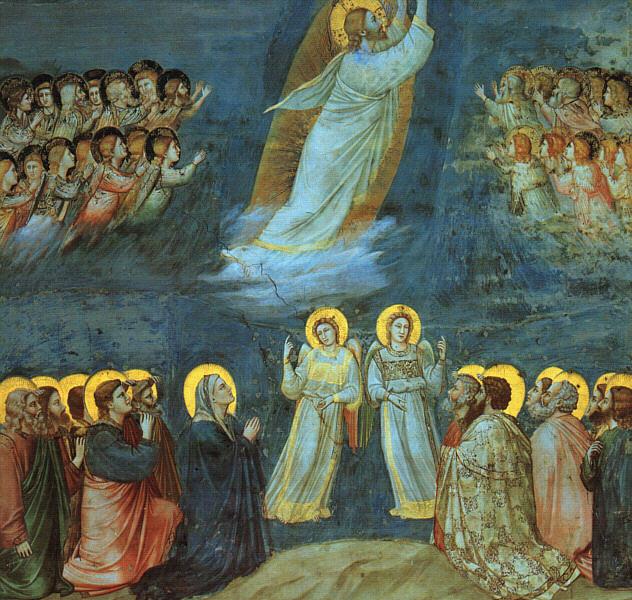Last Sunday, I opened the sermon speaking about the ways the Christian calendar forms our faith. We see the impact of familiar seasons and services to shape us, like Advent and Lent, Ash Wednesday and the Easter Vigil. But there are other holy days and observances, such as Rogation Days, the Feast of the Transfiguration, and Ascension Day, that have been largely neglected for the past 100 years. These are not lesser or minor observances. In fact, the Feast of the Ascension, for example, is a major feast day in our calendar. This holy day celebrates that Jesus is ruling and reigning over all things in heaven and on earth.
Over the past ten years at Apostles, we’ve sought to recover the significance of holy days in the church year that have otherwise been ignored. Now we gather for worship to celebrate Candlemas on February 2nd. Likewise, we have begun gathering for worship on Ascension Day, the 40th day of Eastertide. This year, we’ll gather for the Feast of the Ascension on Thursday, May 18th, at 6pm.
Recovering Ascensiontide
Not only has Ascension Day diminished in modern times, we have lost the significance of the Ascension season, known to ancient Christians as Ascensiontide. Ascensiontide is a brief season with great spiritual significance. Ascensiontide only has ten days, but those ten days are filled with hope and anticipation. Before Jesus ascended to heaven, he promised he would ‘send the promise of my Father upon you.’ But the promise would not come instantaneously. Jesus instructed his disciples to wait: ‘But stay in the city until you are clothed with power from on high.’ (Luke 24.49)
In the book of Acts, we find that after the Ascension, the disciples follow the Lord’s instructions and return to Jerusalem, gathering in the upper room. Luke then names the eleven remaining apostles gathering for prayer with Jesus’ extended circle. (Matthias was selected to replace Judas during the first Ascensiontide, too).
All these with one accord were devoting themselves to prayer, together with the women and Mary the mother of Jesus, and his brothers. (Acts 1.14)
This is the focus of Ascensiontide–the church gathers after Jesus’ ascension to watch and pray; to wait for the promise of the Father, the Holy Spirit; to keep vigil until they are ‘clothed with power from on high.’ Watching, fasting, praying, keeping vigil–these are the purposes and priorities of the ten days of Ascensiontide.
Recovering Ancient Symbols
When ancient Christians observed Ascensiontide, they extinguished the Paschal Candle after the Gospel reading on the Feast of the Ascension. Only since the 1970s have western churches kept the Paschal Candle alight through Pentecost.1 For centuries, Christians have extinguished the Paschal Candle after the Gospel reading on the Feast of the Ascension, symbolic of Jesus’ body ascending to heaven ‘when we will see (him) no longer.’ (John 16.10, 15)
Though we do not see Jesus with our physical eyes, we receive the promise that when he ascends to the Father, he will send the promise of the Holy Spirit:
John 16:7 (ESV) Nevertheless, I tell you the truth: it is to your advantage that I go away, for if I do not go away, the Helper will not come to you. But if I go, I will send him to you.
When we extinguish the Paschal Candle after the Gospel reading, it is both a sign that Christ dwells bodily at the right hand of the Father andhe will send the Helper, the Holy Spirit to clothe us with power. Between the ascension and the sending, we have a task—to pray earnestly for the power of the Holy Spirit to descend anew upon the Church.
Renewing Ancient Forms for a Fresh Outpouring of the Spirit
This Thursday we will extinguish the Paschal Candle following the Gospel reading, according to ancient custom. But we do so, not for the sake of being historically accurate, but to embrace our longing that the living Church be filled anew with the life-giving Holy Spirit. Each morning in Morning Prayer, we pray ‘Clothe your ministers with righteousness and let your people sing with joy.’ In Ascensiontide, we become even more dedicated to pray that all the people of God would be clothed with the power and joy of the Holy Spirit.
How our world desperately needs the life-giving Spirit. The Holy Spirit brings unity, peace, and joy. In our world torn by violence, rancor, and despair, the world desperately needs the Church to be filled anew with the power of the Holy Spirit. That’s the target of our prayers in Ascensiontide.
And let’s not miss the power of our ancient symbols and stories! When the Paschal Candle extinguishes after the Gospel reading on Ascension Day, holy fire returns in the Gospel reading on the Day of Pentecost, when the Holy Spirit appears above the apostles in flames of fire.
So, may the Lord teach us to wait, watch, and pray during Ascensiontide, so that we may receive a fresh outpouring of the Holy Spirit on Pentecost for the life of the world.
- Cross, F. L., and Elizabeth A. Livingstone, eds. The Oxford Dictionary of the Christian Church. ‘Ascension of Christ.’ Oxford; New York: Oxford University Press, 2005. ↩︎


Countless thanks! ✨